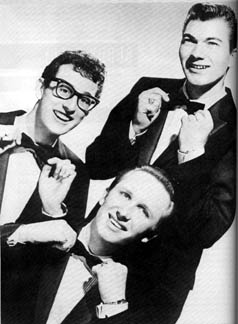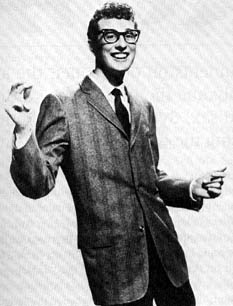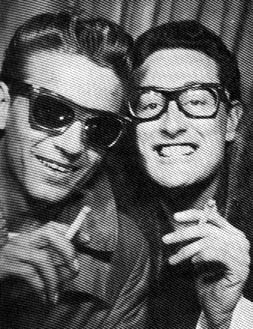[ Previous
| Table of Contents | Next
]
- 1936--born Charles Hardin Holley in Lubbock, TX
- grew up without the primary biracial influence of other rock stars
- almost exclusively C&W without R&B, though you will hear secondary influences at times (like his growls or high falsettos in "Oh, Boy")
- not the typical rock image
- tall, thin, thick horn-rimmed glasses
- performed in a dark suit & bow tie
- not sexually explicit or flamboyant
- more conservative life style ... not boozer, womanizer, or druggie
- lyrics tended to be uncomplicated boy-girl romance, reflecting the fun-loving
teen lifestyle of the 50s
Background info:
- learned to play piano, fiddle, & guitar at early age
- in his teens (early 50s), formed C&W-oriented Western & Bop Band
- performed on local radio shows & recorded demos
- attracted enough attention that he landed a contract with Decca to cut
country singles in Nashville
- --wanted only Holly (not his backup band), so he was joined by Sonny Curtis [guitar]
& Bob Guess [bass])
- --sessions were considered a failure, but one of the last tunes
recorded was "That'll Be the Day" which Decca refused to
release ... executives didn't like it!!
- 1956-57—Holly & friends returned to Lubbock
- opened for many well-knows stars passing through the area (including
a young Elvis)
- Presley influenced Holly's move to rock & roll; said "We owe
it all to Elvis."
- 2/57--traveled to New Mexico, where he recorded a rocking demo of "That'll
Be the Day" with his band, The Crickets

- under the production assistance of Norman Petty who earned a coauthor credit
for his assistance (see a recurring theme?)
- attracted a contract from New York-based Coral/Brunswick label
- song rose to #1 by September


That'll
Be the Day
#1 in 1957; inspiration for the song reputed to by a John Wayne film (The Searchers); see entry in Dr.
John's Bathroom Reader
- artistic decisions influenced (made) by Norman Petty (now Holly's manager)
- typical arrangement today, but not for the times
- through 10/58—due to complex contractual arrangements, Brunswick recordings
were released as The Crickets, while Coral recordings were released under
Holly's name
- distinction is artificial … all were Buddy Holly &
the Crickets
- Holly left Petty & the Crickets due to questions concerning management
- Waylon Jennings & Tommy Allsup became Buddy's new "Crickets"
- the original Crickets who continued on their own with Petty until 1965,
scored some success with British audiences in the early 60s
- began recording with a new softer rock sound (w/ an orchestra!) just before
leaving on a tour with Dion & the Belmonts, Ritchie Valens, & the
Big Bopper (JP Richardson)
-
Holly ... a true Rock & Roll pioneer:
- wrote most of his own material (like Chuck Berry)
- incorporated advanced recording techniques for the time, paying close attention
to the technical side of his recordings
- overdubbing
- double-tracking
- his instrumentation became standard for rock band
- lead guitar, rhythm guitar, bass, & drums
- songs continue to be covered to the present
- "Not Fade Away," "Rave On," "That'll Be the
Day," etc.
- singing style
- "hiccup" singing style
- changing vocal timbre in mid-phrase (normal/falsetto)
Peggy
Sue
- "Peggy Sue" was originally titled "Cindy Lou" ... title
change at the suggestion of Cricket Jerry Allison (drums); "Peggy Sue"
was the future Mrs. Allison—then they divorced
- Holly also gained a high level of popularity in England (toured in 1958)
- 2/2/59—"Winter Dance Party" at the Surf Ballroom (Clear Lake,
Iowa)

- attracted over 1000 people
- tired of bus travel, Holly chartered a plane to take himself & his
band to their next performance (Fargo, ND)
- Valens & Richardson wanted to go too, so Valens & Allsup flipped
a coin
- JP Richardson ("the Big Bopper") had a cold and convinced
bassist Waylon Jennings to give up his seat; in addition, his size made
it uncomfortable to ride the bus
- ill-fated plane trip began in a heavy snowstorm, lasted only a few minutes
before crashing into a frozen cornfield
- "The Day the Music Died" - 2/3/59
- a plane crash (small Beechcraft Bonanza, piloted by Roger Peterson)
- killed Holly (22 yrs old), Valens, & Richardson … as well as the
pilot
photo of the crash site:

- first rock star to die suddenly & unexpectedly
- well, recall Johnnie Ace's Russian roulette incident four years earlier, but Holly was truly a high profile rock star
- the next night, Frankie Avalon & Jimmy Clanton were on the tour ...
Bobby Vee filled Holly's spot
with Fabian & Paul Anka taking over for the other two lost performers
- this replacement of real rock & rollers by pretty faces may be considered
a metaphor for what was happening to rock & roll itself!!
This recording was made in 1971by Don McLean
and refers to Holly's plane crash ...
Proposed lyric interpretations for "American Pie":
It
Doesn't Matter Anymore
(#13, 1959)
topped the British charts for 6 consecutive weeks
- prolific composer—left behind enough demos & uncompleted material to
fill serveral posthumous collections
- 1978—The Buddy Holly Story (starring Gary Busey; nominated for an
Oscar) revived interest in Holly's life & music
- Paul McCartney purchased the rights to most of Holly's songs and remains instrumental
in making sure that "Buddy Holly Week" is celebrated every year
in England (1st week of September)
- 1986—one of the first inductees into the R&R Hall of Fame
- 1989—Buddy (Broadway musical)
[ Previous
| Table of Contents | Next
]
"Oh, Boy")



